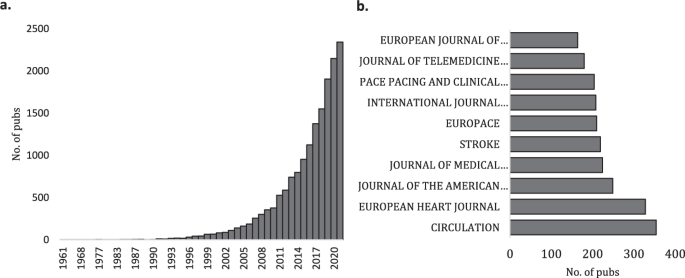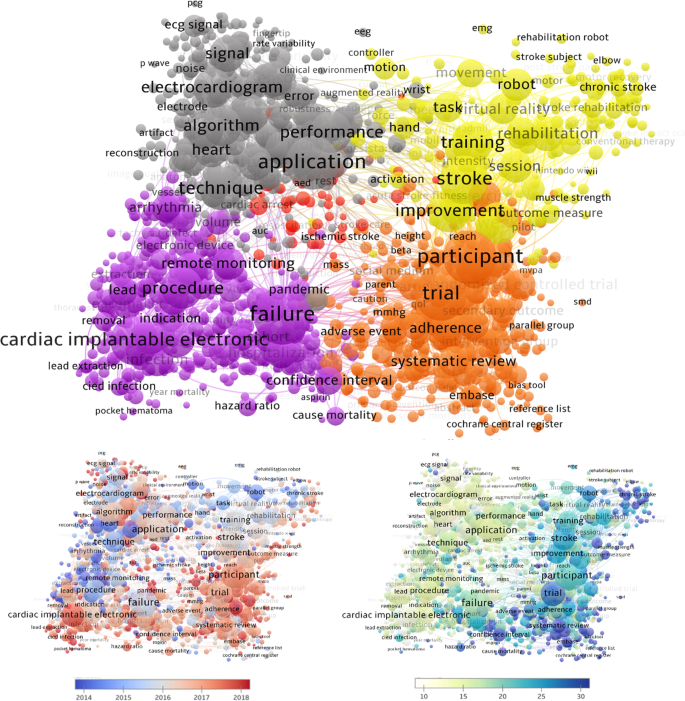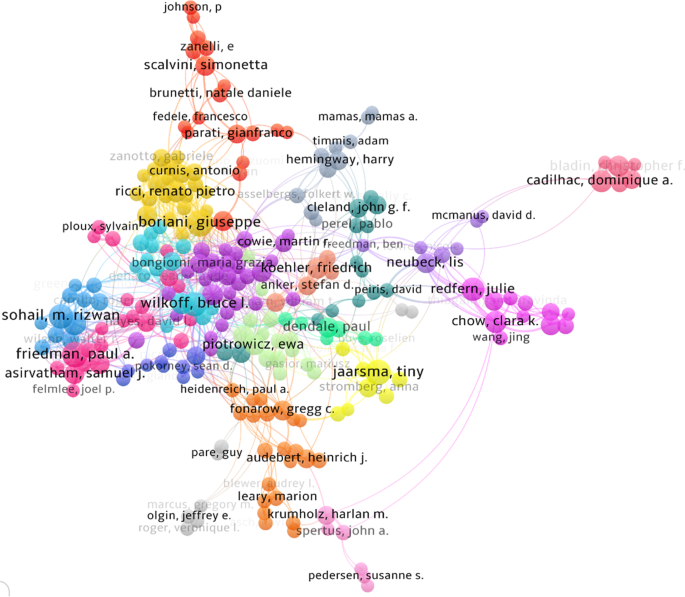Using the search strategy, 16,699 documents were identified in the topic of digital health technologies in cardiovascular medicine. The first article on record, published in 1961 in Circulation is titled ‘Electronic device for accurate identification of cardiac conduction system- its use in open-heart surgery’9. In the period of 30 years to the early 1990’s only 35 more relevant papers were published. Since the mid-1990’s there has been an accelerating publication trend until 2021, when over 2,300 articles were published in year (Fig. 1a). Within the observable exponential trend in this topic, there are no distinct jumps in research activity. Around 60% of the research output is in the form of original research articles (including case studies), followed by conference proceedings papers (14%), meeting abstracts (13%) and review articles (9%).

a Distribution of digital technology research articles (in cardiovascular medicine) from 1961 to 2021; b Major journals within the topic of digital technology applications in cardiovascular medicine.
The top globally cited articles have quite distinct topics (see Supplementary Table 2). The most cited paper is “Flexible polymer transistors with high pressure sensitivity for application in electronic skin and health monitoring” authored by Schwartz, Tee10. The paper has received 1,337 citations in WoS provides information on the fabrication of a novel flexible pressure-sensitive sensor that has high pressure and time resolution capabilities to continuously monitor the human radial artery pulse wave. It is a step-change innovation because previously, only complex instruments such as micromanometers could read a pulse with such accuracy. Furthermore, the flexible pressure sensors developed could be used in mobile health monitoring and remote diagnostics in cardiovascular medicine. Other highly cited papers include topics about health-related behaviours such as sedentary lifestyles11, medication adherence12, robots13, and software14, which highlights the diversity within this topic.
Specific subject areas were identified using WoS Categories. While most of the literature is concentrated in Cardiac and Cardiovascular Systems (n = 4,809, 28%), it reaches across a range of sub-disciplines, including Health Care Science Services (n = 1,643, 10%), Engineering Biomedical (n = 1,449, 9%), Engineering Electrical Electronic (n = 1,255, 8%), Medicine General Internal (n = 1,201, 7%), Peripheral Vascular Disease (n = 1,142, 7%), Medical Informatics (n = 1,118, 7%), Clinical Neurosciences (n = 941, 6%) and Rehabilitation (n = 752, 4%). Circulation and European Heart Journal are the dominant outlets for publications in this area of research (Fig. 1b), with around 700 documents attributed to these two alone.
Author contributors and networks of collaboration
Over 75,000 authors have contributed to the topic, 2,956 of whom have authored five or more articles. Authors with more than 45 contributions include Giuseppe Boriani (University-Hospital Polyclinic of Modena, Italy), Rizwan Sohail (Baylor College of Medicine, United States of America [USA]), Tiny Jaarsma (Linkoping University, Sweden), Paul Friedman (Mayo Clinic College of Medicine, USA), Bruce Wilkoff (Cleveland Clinic, USA), Larry Baddour (Mayo Clinic, USA), Jinseok Lee (Kyung Hee University, South Korea) Julie Redfern (University of Sydney, Australia) and Jenny Wang (University of Sheffield, England).
Publications originating from the USA have been most frequent (n = 5,493), followed by England (n = 1,494), Italy (1,338), Germany (n = 1,191), China (n = 1047), Canada (n = 1030), and Australia (n = 908) (Fig. 2). There are fewer contributions from Africa and South America (except for Brazil). Authors based in the USA are involved in all the strongest collaborations; with England (n = 260), Canada (n = 248), China (n = 163), Germany (n = 163), Australia (n = 159) and Italy (n = 146) indicating that lingual similarities and geographical proximity do not necessarily foster greater collaboration. Collaborations between researchers from English-speaking countries such as Australia, Canada, England and USA and Middle Eastern countries Iran, Iraq and Saudi Arabia are amongst the newest. Lastly, we can also observe that there are few low and middle-income countries producing scholarly research in this area.

The strength of collaborations between researchers from different countries, defined by number of documents, is indicated by the width of the link.
Semantic analysis; keywords, titles and abstracts
Table 1 shows the top keywords (see also Supplementary Fig. 1 for density of co-occurrence of keywords in the literature). In just under two years since the term emerged, Covid-19 (and alternatives e.g. sars-cov-2) have already garnered 270 mentions, reflecting the imperative of managing care when physical distancing is demanded. Keywords also provide insight into the temporal shifts in research and scholarly focus. Table 1 also shows the top keywords with the strongest bursts of citation and the keywords with the most recent and strongest bursts of citation. Children and infants, men, youth, and elderly patients are the populations of interest for scholars, as shown by bursts. Children appeared to be a strong research interest for over two decades (1991-2013), in parallel with research topics such as blood pressure, cardiovascular reactivity and family history.
In the early 1990s, when digital health innovations were rapidly accelerating in cardiovascular medicine research in the early 1990s, the keyword bursts were generally associated with cardiovascular risk factors (e.g. blood pressure, exercise). More recently, bursts of activity are related to modern terminology affiliated with complex data and sensors, including ‘IoT’ (internet of things), ‘neural network’ and ‘photoplethysmography’.
Major divisions of digital technologies in cardiovascular research
Additional insight into topic structure of the topic was found by completing an analysis of the occurrence of terms in the title and abstracts of articles. Figure 3 shows the frequency of the co-occurrence of terms and is complimented by the averaged publication year of articles containing these terms and the average number of citations articles with these terms receive. The analysis revealed that there are five major divisions. Table 2 shows the top terms, most cited terms, and youngest terms for each cluster.

Bottom left: map of average publication year; Bottom right: map of average number of citations. An interactive online map is available here: https://app.vosviewer.com/?json=https://drive.google.com/uc?id=1wo3ylYehGisHVX0CLM49voNitTjKsYOW.
Cluster 1 (Fig. 3; purple, 491 items) focusses on Cardiac electronic implantable devices (CIEDs), including pacemakers, implantable cardioverter-defibrillators and other devices used to help control of monitor heartbeats in individuals with health rhythm disorders and heart failure (HF).
Cluster 2 (orange, 474 items) represents the area of Mobile health technology for secondary prevention of CVD. This includes methods of measuring risk factors and modes for intervention designed to affect the actions that individuals take regarding their health. This division is saturated with terms such as physical activity, healthy lifestyle, Fitbit and step count, and is associated with clinical trials.
Cluster 3 (grey, 441 items) consists of terms related to Wearable technologies. A large focus of this clusters is using photoplethysmography – or sensor-technology to measure physiological parameters.
The last of the major divisions, Cluster 4 (yellow, 195 items) is concerning Technology applications in stroke rehabilitation. Possible interventions for post-stroke rehabilitation have included use of immersive technologies and gamification such as Virtual Reality and robotics for increasing movement.
Using the interactive link to the visual representation (see caption of Fig. 3), it is determined that some of the newest terms in Cluster 1 are related to the Covid-19 pandemic (‘lockdown’, ‘pandemic’, ‘sars cov’). Throughout the clusters, there is reduced occurrence of terms related to minority populations such as ‘disability’, ‘rural’ and ‘culturally diverse’.
The smaller division, Cluster 5 (red, 57 items) consists of terms related to Emergency cardiovascular care. The care and management of out-of-hospital cardiac arrest (OHCA) is evolving and is strongly influenced by emerging digital technologies. Examples include wearable life detection technologies to improve survival, drones delivering automated defibrillators to the scene of the arrest, and advancements in mobile and digital technology used to leverage bystander response15.
Author collaboration
Examining collaboration, Fig. 4 shows clusters of authors who frequently work together to produce scholarly research. This figure does not represent all 75,000 authors who have contributed to this topic overall, only those who have contributed to the central network of research (see Supplementary Table 1 for details of each cluster). There are ten clusters with ten or more authors.

Co-authorship link strength is used to provide an indication of how many publications two researchers have co-authored. Interactive map available here: https://app.vosviewer.com/?json=https://drive.google.com/uc?id=129YuMxn-9sn-ht5mCd88-ADpbh6nX0v5.
Clusters 1, 2, 3, 6, and 10 are groups of scholars researching cardiac electrophysiology. However, there are some minor variations in research topic, for example, clusters 3 and 6 is focused on cardiac resynchronisation therapy, whilst clusters 2 and 6 are looking at lead extraction and management, and cluster 10 is associated with research in infections associated CIEDs. Cluster 1 is very homogenous and based in Western Europe, with few exceptions. Similarly, Cluster 6 is based in North America, with several authors affiliated with Cleveland Clinic. Cluster 5, another group researching thromboembolic diseases and telecardiology, is exclusive to Italian affiliations. Aside from topics related to CIEDs, four of the other major collaborative groups are researching cardiopulmonary resuscitation (cluster #4), telemonitoring in HF and stroke prevention (cluster #7), mHealth and telemonitoring in HF (cluster #8) and secondary prevention of coronary heart disease (CHD) (cluster #9).
The strongest links within this central author network are between Ewa Piotrowicz and Ryszard Piotrowicz (cluster 7, link strength = 23.73), Friedrich Koehler and Kerstin Koehler (cluster 18, 13.50), and Clara Chow and Julie Redfern (cluster 9, 13.78). Almost all the strongest links are between authors in the same cluster, except for frequent collaboration between Julie Redfern and Lis Neubeck (cluster 9 and 15 respectively, link strength = 7.33), which links two groups of multidisciplinary clinician researchers who are focussed on secondary prevention of CHD and CR.
Influential references of digital technology and cardiovascular science literature
Influential articles relevant to the specific topic, ranked by local citation count, are listed in Supplementary Table 3. This metric considers the reference lists of documents in the overall dataset and how many citations the references receive. Based on this metric, ‘Telemonitoring in Patients with Heart Failure’16 is the most influential study in this field. The study indicated that the application of telemonitoring for patients recently hospitalized for HF did not improve outcomes. The other two most influential papers within this topic are ‘2016 ESC Guidelines for the diagnosis and treatment of acute and chronic heart failure’17 and ‘Update on Cardiovascular Implantable Electronic Device Infections and Their Management: A Scientific Statement From the American Heart Association’18. The last of which provides an important update on recommendations for the care of patients with infections due to CIEDs, as well as highlighting the research gaps. Studies, reviews, and guidelines focussed on HF, telemonitoring and CIEDs dominate the list of top ten locally cited articles.
Additionally, we can observe the articles that have had the strongest burst of citations since publication (see Supplementary Table 4). The subjects of all of articles with the strongest bursts are related to telemonitoring or remote monitoring. The top two are ‘Noninvasive home telemonitoring for patients with heart failure at high risk of recurrent admission and death: the Trans-European Network-Home-Care Management System (TEN-HMS) study’ (strength = 36.55)19 and ‘Structured telephone support or telemonitoring programmes for patients with chronic heart failure’ (strength = 31.81)20.
Temporal evolution of digital health technologies in cardiovascular research
The growth and temporal evolution of this topic was visualized using document co-citation methodology. Figure 5 shows a birds-eye view of the twenty major divisions – or research streams – in which digital technologies have been applied in cardiovascular research (Supplementary Fig. 2 shows the research streams in a timeline format).

A dynamic visualisation of the interplay between the research areas (from 1990 to 2021) is accessible via this link Temporal map_digital health_CVD.mp4.
Figure 6 provides a visual representation of the extent of research activity within each stream of digital health applications within cardiovascular medicine (1990-2021) (see Supplementary Fig. 3 for deeper insight into the twenty research streams). It is evident that within the major streams, blood pressure reactivity, bypass surgery, cardiac reactivity to gaming and gamification are no longer active research areas in digital health applications. We can clearly see that there are emerging and heightened research activities in the areas of cardiac rehabilitation and out-of-hospital cardiac arrest. Research in remote monitoring, Virtual Reality, HF, transvenous lead extraction, remote monitoring, and arrythmias emerged between 2000-2010 and have maintained a high level of scholarly interest since. Research into the application of wearables (smartwatches, body sensors etc.) and activity tracking for cardiovascular care, and eMRs, appeared to peak between 2015-2020 but are now showing signs of slowing down. The oldest clusters, as determined by the mean year of article publication are Cardiac reactivity (1981), and similarly Blood pressure reactivity (1984), and Software analysis of cardiac output (1989). The average year the citing articles are 1991, 1993 and 2007 respectively, showing that there is little or no modern research being conducted in these areas. Contrastingly, looking at research activity we can see that the most modern topics are Cardiac rehabilitation (mean citing year 2018), Activity tracking (2018), Radiology in patients with CIEDs, (2018), Arrythmias (2019) and Out-of-hospital cardiac arrest (2020).

Left axis: total number of citations; Right axis: total number of citing articles. Note: scale is different for each cluster.
Cardiac rehabilitation is an interesting cluster in that it has some of oldest articles, dating from 1954, but it still a modern-day research area. The earlier papers from mid-1970’s-1980’s have a focus on behavioural change and self-efficacy21,22.
A paper by Chow, Redfern23, titled ‘Effect of Lifestyle-Focused Text Messaging on Risk Factor Modification in Patients With Coronary Heart Disease A Randomized Clinical Trial’ has received the most local citations (n = 131, and globally n = 554) as well as having the strongest burst of citation (13.05) between 2017-2021. Chow, Redfern23, whose focus is secondary prevention of CHD, shows that using a text-message intervention may improve cardiovascular risk factors such as blood lipids, physical activity, blood pressure, BMI and tobacco intake; a clear example of a simple digital health application for improving cardiovascular care outcomes. Lastly, research related to HF, CIEDs and remote monitoring make an appearance in more than half of the research.

